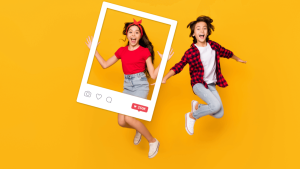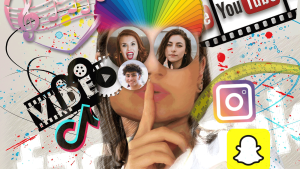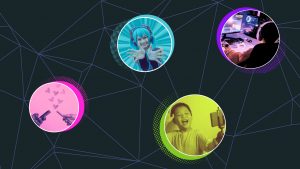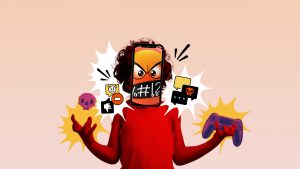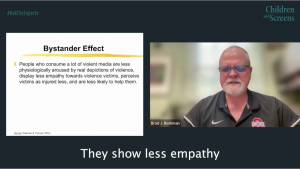
“How do these “influencers” actually impact children’s choices?” “My 7-year-old daughter is obsessed with watching toy reviews online, should I be concerned?” “Is watching influencers online impacting my 12-year-old’s social development?”
Celebrity is hardly a new phenomenon; however, thanks to the digital age, it’s never been easier to become the next big thing. Young people in 2021 consume media in a rapidly-changing landscape, and experience a personalized digital experience every time they glance at a screen. These experiences are crafted to feature the latest influencers and kidfluencers, who expose children and teens to subtle and overt advertisements, as well as new social trends.On Wednesday, October 20th, 2021, Children and Screens hosted “The Influencer Impact: How Social Media Stars and YouTube A-Listers Shape the Way Kids Think, Act, and Interact,” an Ask the Experts webinar, featuring an interdisciplinary panel of distinguished experts. They discussed the motivations and implications of the kidfluencer and influencer age, as well as how to help your children thoughtfully and carefully navigate the world of young social media stars.
Speakers
-
Sherri Hope Culver, MLA
Director, Center for Media and Information Literacy, Associate Professor, Klein College of Media and Communication, Temple UniversityModerator
-
Pamela Rutledge, PhD, MBA
Director, Media Psychology Research Center, Doctoral Faculty, Fielding Graduate University
-
Liselot Hudders, PhD
Associate Professor, Director, Center for Persuasive Communication, Ghent University, Belgium
-
Elizabeth Milovidov, PhD, JD
Digital Parenting Coach, Founder, Digitalem, Assistant Professor, American Graduate School in Paris
-
Marie Bragg, PhD
Assistant Professor, Department of Population Health, Grossman School of Medicine, New York University
2:34 To kick off the conversation, moderator Sherri Hope Culver, MLA, highlights the many ways influencers shape our lives and share their “buy it” messages presented as though coming from a friend. After introducing the panel, Culver asks the audience to share their concerns and what they perceive as the benefits of kidfluencers.
8:36 Presenting the panel with the million dollar question, Culver asks “why do kids trust kidfluencers?” Liselot Hudders, PhD, Associate Professor and Director of the Center for Persuasive Communication at Ghent University, explains that influencers create the feeling of intimate friendships by sharing authentic details of their lives and unique perspectives disguised as expertise. Pamela Rutledge, PhD, MBA, Director of the Media Psychology Research Center and faculty at Fielding Graduate University adds that paying attention to social influencers, whether online or off, is completely normal, and urges parents to tread lightly when talking about influencers because knowing what these influencers are up to is important offline social capital for many children.
17:32 So what can parents do? Promote media literacy and encourage critical thinking skills when it comes to consuming influencers’ content. Elizabeth Milovidov, PhD, JD, Digital Parenting Coach and Assistant Professor of American Graduate School in Paris, reiterates the immense power of influencers – for better and for worse. Dr. Milovidov recommends ongoing conversations with young people asking questions about what is real and what might be doctored for social media, as well as asking why people are posting these videos and why kids find them compelling. Dr. Rutledge adds that influencers have created an unrealistic expectation of what life might look like for people of all ages, so parents should ask questions and be curious to help bring kids back down to earth.
25:35 Marie Bragg, PhD, Assistant Professor in the Department of Population Health at the Grossman School of Medicine at New York University joins the discussion and offers her insight into the ways kidfluencers advertise food and beverages, especially unhealthy items – 90% of the foods and beverages shown in kidfluencer videos are unhealthy products – by embedding ads directly into their videos. Dr. Bragg notes that sometimes it is difficult to tell whether a video is sponsored or not, and Dr. Hudders adds that sometimes recommendations are given without sponsorship because influencers are building their expertise and fan base. Both emphasize that if you don’t know whether or not it’s advertising, it’s difficult to be critical. Dr. Rutledge adds that kids don’t care if it’s advertising or not, as long as their parasocial relationships with the influencers are strong, adding complexity to parents’ ability to teach critical thinking. Parents should educate themselves on the tricks of the trade so that they can help their kids approach influencer videos with caution.
43:49 After establishing how influencers impact young people, the panel discusses what parents can do if their kids want to be influencers. Dr. Hudders’ research reveals that parents are really the ones managing these profiles and using their children to attract commercial deals. Nevertheless, being an influencer is the most attractive “dream career” for children today, and so there may be pressure from both sides. Dr. Rutledge recommends that parents help children manage their online vs offline identity conflict and work carefully to navigate the volatile experience of fame. She emphasizes that it’s a lot of work to succeed as an influencer, and if this is the choice for your family, it should be motivated by the child, preferably within a context of them wanting to help the world in some way. Dr. Bragg chimes in encouraging parents to establish and maintain boundaries around appropriate content to create and items to review. Dr. Milovidov shares some legal advice, reiterating that parents should prioritize children and be their legal and psychological guardians.
58:00 To wrap up the webinar, Culver facilitates a more rapid-fire Q&A session with questions from the audience, touching on the importance of racial and ethnic diversity online, how parents can cut through the drama to emphasize the reality behind influencer videos, how parasocial relationships influence real life friendships, and the right age to begin teaching digital literacy.
[Dr. Pam Hurst-Della Pietra]: Hi and welcome everyone. I am Dr. Pam Hurst-Della Pietra, president and founder of Children and Screens: Institute of Digital Media and Child Development and host of our “Ask the Experts” series. We are so glad that you joined us for today’s popular webinar about kid influencers (kidfluencers), a group who has taken the world by storm, changing the way kids around the world are engaging with pop culture and influencing their thoughts and behaviors about just about everything, from new products, to what they want to be when they grow up. We have convened an outstanding group of experts to share their insights into this phenomenon that has many parents concerned. After they discuss this new trend, the group will be happy to answer your burning questions. Just type them into the Q&A box at the bottom of your screen. When you do, please indicate whether you’d like to ask your question live on camera or if you’d prefer that the moderator read your question. We are recording today’s workshop and will upload a video to YouTube in the coming days. All registrants will receive a link to our YouTube channel, where you will find videos from our past 36 webinars, which we hope you’ll watch as you wait for this video to be posted. Before I introduce today’s moderator, I have an exciting announcement about a new Children and Screens opportunity. One of our almost 500 registrants today may choose the topic of our “Ask the Experts” webinars for next year. Between today and Friday, November 19th, when you donate at least $100 to Children and Screens: Institute of Digital Media Child Development, you will automatically be entered into a raffle to choose the webinar. The funds will support the institute in providing more terrific webinar programming. Visit our website at www.childrenandscreens.com to learn more. Now, without further ado, it is my pleasure to introduce Dr. Sherri Hope Culver, our moderator for today’s webinar. Dr. Culver serves as director of the Center for Media and Information Literacy, CMOL, at Temple University, where she is associate professor in the Klein College of Media and Communication. Sherri’s teaching and consulting focuses on media literacy and media institutions with a focus on children’s media. In addition, she serves as vice chair of the Global Media and Information Literacy Alliance, a UNESCO led alliance of over 600 organizations from 80 countries. Welcome, Sherri.
[Dr. Sherri Hope Culver]: Hi, everyone. Influencers, that’s our conversation today, right influencers is a term that gets tossed around a lot these days, but it’s actually one of the rare instances where the term that we’ve attributed to something actually states pretty directly exactly what that something is because at the core, we watch and follow and take advice from people who post videos and photos online. What’s happening is influence, influencing what we think about, where we think about and how we think about it when we think about it. And all that happens because of the who, right, who convinces us to think about it and we are influenced. Advertisers know that we’re more receptive to messages conveyed by an influencer, and you’ll hear conversations about that today. We listen more attentively, more moves to purchase. The effect is powerful, and if it’s affecting us as adults and it is, then it’s having an even greater effect on children. It’s almost, I don’t know, kind of adorable to think about the effect that we used to worry about with commercials when kids would see commercials, when I was growing up. And now the message, that “buy it” message, is coming wrapped in a friend, and I just want to quickly show you a picture of some of those friends. These are the top eleven child YouTubers right now, kid influencers. And if you are, you may look at some of those faces, they may look familiar to you. Like Nastia, the data this year is from 2020 in terms of her subscribers, though she has even more subscribers now and Diana has another one. So there are lots of folks here that you meet some of these folks may be familiar with, to you. I’m going to stop sharing my screen for a minute, but we’ll be talking about so many of them. So that friend that the child looks at might be a little older than them, right? After all, we say children, we’re talking eight years old, ten years old, twelve. But that child knows where the friend lives, what she has for breakfast, what makes her cry. And that deep feeling is affecting kids’ understanding of what’s important and what’s normal and what they should value. So how does that influence differ when the friend is another child versus when the friend is more like a role model or in your peer? So today on this Children and Screens webinar, we’ll explore how these influencers shape the way kids think and act and interact. And let’s get right to the amazing panel that I’d like to introduce you to. The first is Dr. Pamela Rutledge. She draws on her background as a media producer and psychologist to make sense of life in a digital world. She’s on the Faculty of Media Psychology at Fielding Graduate University. Dr. Rutledge teaches and researches topics related to audience engagement, media experience and narratives. Identity construction. Dr. Liselot Hudders is an associate professor at Ghent University in Belgium and director of the Center for Persuasive Communication. She conducts research on how children cope with digital advertising and how behavioral change can be fostered through communication campaigns. Dr. Elizabeth Milovidov, is a lawyer from California, a law professor in Paris, France, and a digital safety consultant in Europe. Using her European-American focus on internet technology and social media issues, she researches solutions to empower parents to guide their children in the digital age. And Dr. Marie Bragg’s work focuses on identifying and affecting environmental and social factors associated with food marketing and diet related health disparities. She was trained as a clinical psychologist. Dr. Bragg utilizes psychology and public health research methods to study food policy and diet related illness. Her research advocates for changes in U.S. food policy and population level solutions, not only individual behavior change. So before we let the panelists begin talking about that, I do have a question and we have a little poll question for everybody who’s watching and listening. What are your concerns about kids and influencers? What are the benefits of kids and influencers? So a poll is going to pop up on your screen. You should be seeing it right now. You’ve got to choose your top three concerns and the top three benefits that you see. And if you can answer that quickly and submit that, that’ll give us some input for our discussion as well. I think everybody has everyone’s polled, and I think I will see see the results of that. They’re going to come up. I feel like I need to be singing the Jeopardy song while everybody’s waiting and filling things out. So if we’re waiting for that data to come back, maybe in the meantime, we’ll get started with our conversation. Let’s begin peeling back the why of influencers in the psychology of influencers. Liselot, maybe you can kick that conversation off. How? How are they? Oh, of course. Now we’ve got our pros and cons. OK, I’m going to, I’m going to give you a moment to think about that. Let’s just take a quick look at what the top answers were. It looks like the top three were when watching kids, when watching these kids develop their identities as consumers could influence their video, kid influencers provide access to problematic risk and inappropriate content. There was another. Oh, here’s the 50% right. Watching these videos encourages obsession with celebrity culture, so that was the concerns and the top benefits. Look like the top three are: kid influencer, kidfluencer culture enhances friend networks and kidfluencers are able to create a more confident personality than in real life. And here’s another 32%. Kids can learn about academics and careers from kidfluencers. I don’t think they meant kidfluencers. I think they meant kid influencers. Maybe that was just an error there. OK, so going back Liselot, how? How, why do people trust influencers? How are they influencing? What are they actually doing? And I’ll turn it to you.
[Dr. Liselot Hudders]: Thank you. But what you see is that they spent a lot of time building an authentic profile, so they want to create a unique identity which distinguishes them from others from other influencers and make them unique because they want followers to watch their content. So for children or adolescents, and even for us as adults, it’s fun and entertaining to watch their content. We also like to have a sneak peek in the lives of others. You see who their friends are, who their family are, what they like or dislike. So we really get to know them very, very well. So what we are doing is building an intimate bond with those influencers. They are showing updates of their lives during the day. Even when you wake up, you can see what they are doing, in the evening when you come home from school, for instance, you have new updates. So you really have the feeling that you know them very well. It’s that you know who you are. And another thing that makes it so different from TV stars, because you also can have the feeling that you have a bond with television characters that you are watching every day, is that you can really interact with those influencers. You can comment on what they post and they can also respond to you, and they can thank you for commenting on my posts. And how are you today? So you really built a close relationship with them. It’s mentioned as a parasocial relationship. So this friendship once and the fact that their content is so unique and authentic makes them very persuasive and very attractive for people to watch. Another thing is that they are really building expertise in a particular domain, so they are specializing in a specific niche: food influencers, fashion influencers, and thereby they make inspiring content and people watch that content to see the latest trends, the new updates, and it helps them to build their own lifestyle. So because they are really experts in a domain and they give you insights and new trends, you really believe them and trust what you are seeing and you are really looking forward to see the new ads and new content. And because of this expertise, this intimacy, you really are very first created by those influencers.
[Dr. Sherri Hope Culver]: That point about believing them, I think, is such a powerful point you made Pamela, that leads me to thinking about that psychological impact. So what is the psychological impact on children? What does it mean for a child to actually form that relationship, take all those steps with an influencer?
[Dr. Pamela Rutledge]: The relationship that kids have with these influencers or that people have with celebrities in general is generally referred to as a parasocial relationship. That means it’s a one sided relationship. It’s been studied in the literature since the 1950s. But what’s especially interesting is that social media has really upended how we think about parasocial relationships because you actually couldn’t interact with Oprah unless you were in the television audience. But you can interact on social media with influencers, particularly with what they call micro-influencers that have relatively small followings that really do engage with their fans. But the first thing I want to warn parents is this is totally normal, right? Kids liking influencers is a perfectly normal stage of their development. It’s how they form their identity. It’s how they learn how the world works. They pay attention to their peers, too. They’re watching everything social. That is developmentally appropriate. They do feel like these people are real friends. They are intimate. They share a lot of details. And there’s an emotional investment because they can see how popular these influencers are. There’s a big social influence in terms of being part of the gang, having an affiliation with an influence, not missing out. You know, we talk about FOMO is fear of missing out of what your friends are doing, but you also don’t want to miss out on what the influencers are doing because that’s offline social capital for most kids. They take this offline. They talk about it with their friends, and it has real meaning. So parents, be very careful how you talk with your kids about influencers, because if you disrespect that influencer, you will shut them down. That’s like insulting one of their best friends. Don’t force your kid to break up with their influencer. You can cause more of a pushback then you’re trying to achieve in reorienting how they think. But I want to just focus for a second on what it is about social media that has changed that level of connection. one is, of course, access, right? You have access 24-7. Everywhere you go, for the most part on a mobile device in your back pocket, you never have to leave these friends at home. They are intimate, they’re sharing their details, and part of that intimacy is created by looking directly at the camera. They are breaking what they call in theater, the fourth wall. They are talking to the child. They are speaking in their language. They have also created these videos and on. I encourage you to look at some of these videos. They have edited it so that it is culturally appropriate. It’s quick cuts. There’s editorial commentary. It sort of looks like the old old comic books powerbanks bang, boom, right? There’s all kinds of exclamations and things going on to keep kids engaged. And kids are commenting. They comment to each other. They build communities around influencers. So it’s a much more complicated thing than just liking an influencer. That liking, however, increases trust, and that trust increases persuasiveness. But remember that the human brain was not developed for social media. The human brain was developed and we were out wandering around on the savanna, looking for saber tooth tigers when someone makes eye contact with us. We interpret that instinctively as if it were real. So there is an intense emotional connection by that repetition of consumption of these, this kind of media. So the positive side, it’s not all negative, right? The positive side is that it can create an increased sense of belonging. There are an awful lot of stories about kids, especially during COVID, who felt totally cut off from their friends who are able to feel a sense of connection by connecting through social media, by influencer sites and by sharing ideas. It can also support identity information formation by showing you different ways of being, showing you people like you with your interests where you can sort of deep dive into these different communities. They don’t have to be showing you bad things. Sometimes they’re very inspirational. There are a whole bunch of influencers not yet old enough to vote, who during COVID took up campaigns to get people out to vote, or to encourage people to make positive social change to get involved with different social causes like Black Lives Matter. So there’s a lot of positive that goes on. That being said, there are negative things that happen to right. It can internalize unrealistic or unachievable goals. We worry about beauty on Instagram social comparison, but it’s also true with how we think about popularity. What makes a friend? What’s a real friend? What makes me popular and it influences behavior, and it can encourage perhaps not the smart, smartest choices in behavior when people are trying to get attention on social media. But the most important negative is that it’s shifting from internal competence to external competence as a marker of success. All is not lost, right? Parents can take several steps to mitigate these negative influences. And we’re going to be talking about that all along the way. But I think a recurring theme is here is going to be the importance of introducing critical thinking, a level of media literacy in how your child engages with social media influencers.
[Dr. Sherri Hope Culver]: That’s actually a great segue to question, I was going to ask you, Elizabeth, about critical thinking questions. So how do we and we begin to have those conversations as parents and what are the kinds of topics we need to bring up?
[Dr. Elizabeth Milovidov]: Yeah, I mean, I just love it. It’s so true that critical thinking, digital literacy, these are the key things that parents need to be thinking about as ways to have our children have a better experience. So when I say children, I mean children and teens and young people, and this is the best way that we can support them in the digital environment is getting them to ask those sorts of questions. Because let’s face it, social media influencers, they are powerful. They’re more powerful than celebrities. And again, whether this is a negative or a positive effect and please again, parents, let’s let’s stay positive and realize that we can’t see a positive effect of social media influencers. And this is what we would like our children to see and to do is to have sort of a social media for good. But I think if we pull it back right now, we’re post-pandemic. Parents have had this sort of wake up call as to what our children and teens are doing online. And I think this is a great moment to get started having those conversations with our families that really just kind of shape everything that we want to do. And we can really begin as we mean to go on by using critical thinking to help us out. So again, when we’re talking about in this social media influencer sphere, there’s so many different things between what’s real and what’s not real. So put on the critical thinking caps, you know, let’s talk about this. Ask your team, do they understand what they see online isn’t always true. You know, we see the beauty bloggers, the gaming bloggers. I mean, you name it, there is a blogger, vlogger, influencer who is doing that and showing that and what they’re showing is not always exactly what it looked like before they got started or before they spent hours, you know, putting hairspray on it to make it shine. Whether it’s food we’re talking about things to do with food, right? So it’s really being able to use this critical thinking and thinking about it and asking your teen, Well, you know, how do you like fit into all this? Because will the influencer, will they make more money if they have more likes, more views and content? The answer is yes. So it’s things like that where you have your child thinking, Hmm, maybe there’s more to it than this. I think again, as we watch television reality stars, it’s the same thing with social media influencers. Do you really think that’s the real life that they’re just walking around in bikinis and, you know, great bodies and this whole bit all the time? Of course not. So it’s kind of bringing the back down to Earth and the real world before we hear action and take one. So it’s these types of who, what, where, when, why questions about what they’re actually seeing and what they’re experiencing. And I really would like to stress that what the teen is experiencing, meaning does it make them feel more positive if it’s not making them feel more positive and there’s a whole critical thinking exercise there? Well, why are you watching this? Why are your friends watching this? And really, those are the types of conversations that we can go on forever. But I think it’s so crucial whether we’re talking social media, video gaming, whatever that really we all put on our critical thinking caps and we help our children, teens and young people to do the same. Yeah, I’m going to hand it over to you, Sherri.
[Dr. Sherri Hope Culver]: I have to ask a quick follow up question to you because you mentioned parents, you know, engaging with their children in those critical thinking questions. But what about whether the what do we know about whether the parents are doing that themselves? These will be left for your kids.
[Dr. Elizabeth Milovidov]: Yeah, well, already you are. I think you know the answer if parents aren’t always doing it for themselves, right? And this is a true problem in this whole digital family environment is that sometimes not all the time that parents and caregivers have a little difficulty, to see how sweetly I’m saying this, have a little difficulty being digital role models, myself included, right? But I think that as long as we’re aware and even then, you can share your experience, that negative experience with your teen too and say, Look at mom, I, you know, I am stuck on this Instagram feed as well. What kind of strategies can we possibly think of together, both of us, so that we can have more time together? And instead of having Mommy Feed, Daughter Feed that we get off our feeds and we go outside to do some mommy, mommy and daughter spa time, right? Sorry for all the moms. Daughters are going to ask for a spot on now, but hey, it’s an offline activity together
[Dr. Sherri Hope Culver]: And I love that idea, but you’d actually be strategizing for that together. But thinking more about the development, the child’s development, our internal, our kids development, and they’re watching, they’re not always watching influencers who are their age, they’re watching kids who might be much older. Pamela, can you talk to us a bit about the social development in that? Situation, what what, what it’s like when children are watching, you know, other city teens or young adults and they’re getting their role models from then.
[Dr. Pamela Rutledge]: Well, the influencer culture has really changed a lot of perspectives, and it’s giving people access to a lot of what we call different ways of being, which is what psychologists like to call different lifestyles around the world, and it’s made some things very attractive. So it’s actually created in some senses an unrealistic expectation about what it means to be successful in life. People worry, however, about Oh my gosh, my kids watching an influencer all the time. They’re never going to be able to talk to their friends. They’re not going to have any friends. Just like when they learned how to text, they completely forgot how to read English. You know, all of those worries are overblown. The connection to the influencer is degrees. It’s just like anything else. There are problematic levels of connection and there are very healthy levels of connection. So just remember that because there’s a connection, it isn’t negative. That being said, you do want to as the parent, and I don’t care how old your child is, you do want to bring them back down to earth. You want to. With young children, the gold standard is coaching. We’re on Tik Tok. You can pair your app with your kids app so that you can curate their content. You can ask questions and be curious about why they like someone, and you can encourage those kinds of behaviors that support their social development. Now that being said, I want to say that social media has been a real boon for kids with social anxiety disorder or kids who are suffering from various kinds of social. I don’t want to call them disabilities. That’s not what I mean, but where they have lack of confidence. Socially, it allows them to participate in a social environment and sort of develop their ‘sea legs’ and get used to it so that when they do go offline, they are much more confident. So don’t worry about them losing all their social skills. They’re actually observing social skills. They’re also observing social skills that don’t work, and that’s a wonderful learning opportunity when they see people behaving badly. So you can step in as a parent and help and ask questions. Point out, why is that funny? Why is that not funny? Why does that person annoy you? You know who has the off button here? You know? Taking charge is really what you want kids to do. That’s the best thing you can do for their social development, is making sure that they’re competent enough to be behind the driving wheel.
[Dr. Sherri Hope Culver]: Yeah, I’m hearing a lot from both Elizabeth, from you and from Pamela, lots of these why questions, right? That’s what comes up. A lot of these “why” questions, but you also start to touch on, Pamela, that there are like specific issues for specific environments, specific situations. So let’s explore some of those. Marie, I would love you to talk about your specialty, which is around body and food and food access food imaging. Can you talk to us about that? The representations that kids are seeing around body image and obesity and advertising health advertising.
[Dr. Marie Bragg]: I think the best way to show how advertising is interacting with these kid influencers is to show a few images, so I’m going to just pull up a slide here and show this was a study that we did about a year ago, and what we did was document how kid influencers were including unhealthy food and beverage brands in their YouTube videos specifically. So a lot of those kids will be interested in what Sherri showed in our sample. And so this is an example of how we’re seeing food pop up as we’re hearing about the ways that media is changing and as opposed to traditional ads on TV where we might have someone holding up a Coca-Cola or something and saying, I drink this because it’s delicious and it’s great. We’re now seeing it embedded into the content in ways that are fun and funny, and you can see the number of views here in the number of subscribers. This was from a while back, but I think that this gives a sense of how organically and I guess that’s an ironic term for dependents, but how organically the products are woven in via a story or a game or, you know, having failed videos. And so in our study, we found that the majority of products that were shown, actually 90% of them, were unhealthy and we saw kids as young as this child, who their mom squeezed pop rocks into their mouth. You’ve never had pop rocks. It’s candy that has little explosions, and so it feels like it’s sort of popping or exploding into your mouth. And I think he was around a little over one or so. And so we like to think about these things in the context of part of policy. And I’ll stop sharing now, but we like to think about those in the context of policies and sort of what we can do to make the landscape healthy. Because everything that we’re hearing about sort of the poor social relationship and the conversations that parents need to have with their kids are so important. And at the same time, we also want to set parents up for success and set kids up for success so that we’re removing some of the riskiest behaviors. And in our group, we talk about the health factor because we really want to set kids up for a long, healthy life because we know if you’re obese as a child or an adolescent, it often carries into adulthood. And so we’ve really seen a lot of kidfluencers having their food and beverage products appear in their videos. And it’s sort of subtle, so we’re not sure if they’re being paid for it or not. But what we do know is that these kinds of images are persuasive. So there’s a lot of work to be done in this area, for sure.
[Dr. Sherri Hope Culver]: Sure. Yeah, it’s hard for me to get that image, the pop rocks in that. Yeah, that really is quite stark. I don’t even like pop rocks in my mouth. Those are scary things. There’s actually a study that an organization called Smarty Pants does a study called Brand-Love every year. And they, you know, they talk about the brands that kids love. And not surprisingly, you know what? Well, I should say not surprisingly, but they’re basically there’s two categories in that list: One is media, so things like Netflix and Apple and YouTube and YouTube Kids, and then it’s candy, right? That’s the other category. So if you have somebody who is, you know, someone you trust showing you both candy and food items, of course, that’s going to have so much influence. Which leads us to thinking about the ad-traditional advertising and this nontraditional advertising. Like, you do a lot of work looking at the ads and the influence of those ads. You talked to us about that a bit.
[Dr. Liselot Hudders]: Know, well, the main problem this year is that it’s very difficult to know if it’s advertising or not because it’s so integrated and the regular accountants, the influencers give recommendations all the time because they built expertise in a domain. They want to show the trends so they get product recommendations, and you really believe that they really liked the product that they are promoting. So it’s very, very difficult to know what the commercial deal is behind the post. And if you don’t know if it’s advertising, then you are not critical because you don’t activate your advertising literacy. So all the knowledge and skills you have concerning advertising, and it helps you to critically reflect on it and ask yourself questions about Is it really a good product for me? Is it? Why is the influencer promoting that particular product? Not other products that are healthier are better for me. So that’s a real difficulty. It’s also very difficult to know if it’s really advertising because in many European countries, there is some disagreement when we can classify sponsored influencer, influencer post, as advertising. If the influencer just receives the product for free and the advertiser is not giving any instructions about how to do posts or how to portray the products online. Is it then advertising or is it just a regular e-word of mouth? So is it just a regular recommendation? So that’s a real difficulty. So I believe it’s very important to help your child recognize sponsored posts and talk about what’s what’s it mean motivation can be of the kids showing the products and how it’s reflects reality or not, because some materialistic lifestyles can be promoted because the gifs show all the toys they receive and unpack those toys in videos. So it can be very hard for children to resist all those nice, nice stuff and not also want to receive those free gifts from other times.
[Dr. Sherri Hope Culver]: Can you elaborate a bit on what parents should be looking for in those situations, so, you know, whether we know behind the scenes, whether there was money that changed hands or not? What are some of the things that when they’re looking at influencer content that could help them to notice that?
[Dr. Liselot Hudders]: There is a lot to do about the disclosure, so if you are sponsored, if you are paid to promote a product, you need to disclose it. You can use the platform disclosures or you can use a hashtag like #advertising, #sponsoring, and #sponsorship so that can help you to recognize the sponsorship. It’s also, if giveaways are used, then it’s also an indication that it’s not a free, free thing. So I think for parents, it’s really important to discover the sponsored content together. It’s akin to kids and help your kids recognize that, and then it also helps it reflect on how it should think about it and it helps to think about if it’s appropriate or not. That’s the claim that our needs are honest and how they are persuaded by it.
[Dr. Sherri Hope Culver]: Yeah, those brand and influencer relationships can be very difficult to decipher and to and to, you know, as people that are watching, we don’t always know the relationship and what’s been going on there. Camilla, can you talk a little bit about that influence between the brand and the spot, the sponsor in the audience?
[Dr. Pamela Rutledge]: Oh, sure. And there was one thing that I was just just wondering when we’re talking about the influence of advertising is that there’s a certain body of research that says the intensity of the parasocial relationship actually can negate the disclosure so that kids actually don’t care if it’s being sponsored, if they like the influencer enough. And so I’m wondering if anyone on the panel has had experience in addressing that sort of heightened level of “I don’t care that you’re being sponsored”, sort of ignoring that, that high level of persuasion. But I think it is important to recognize that there’s an increasing pressure on brands these days to be more socially responsible. Is it, are they all perfect? No, of course not. But there is. There has been some movement in that direction. And so what I’ve noticed with influencers lately is the ones who are bringing down the big bucks like Ryan’s world, who was like $29 million dollars in the last year or some crazy amount with 41 million subscribers. He’s now sponsored by Walmart and he’s sponsored by Target, and he’s making educational videos on how tsunamis occur and you know how to brush your teeth properly. So there seems to be some shift from the brand side in pushing for more responsible content. Now, does that mean that pop rocks isn’t going to still send out boxes? I’m quite sure they will, but I think that it’s it’s good to watch for those kinds of things and reward the brands that are doing a good job.
[Dr. Sherri Hope Culver]: You know, we we have to note, though, that the main reason likely that Ryan was doing that and shifting to educational is because he got in a lot of trouble doing content for YouTube that was deemed to be advertising after saying it’s not advertising, it’s not advertising for years and years and years. You know, you were asked before about, is there someone you anyway have a story about this relationship? And I thought of something that, while it has to do with college students, I’m curious if folks have had this experience, which is that when I talk to my college students about their relationship with influencers, their feeling is very strongly that they can believe influencers. That actors. I’ve had children say the actors are pretending YouTubers are real and that if they stand up and say, like, this is the pen I use, this is a great pen. I love this pen. They would not lie to you because they know they would lose viewers. So they feel that whether there’s money changing hands or not, they feel very strongly that what they’re being shown is or is an authentic opinion about something. Anybody comment about that? Elizabeth, do you have a comment on that? No, you’re right. It’s a problem. Exactly. Lisa please go ahead.
[Dr. Liselot Hudders]: We did some interviews with teen influencers and we noticed that it’s very difficult for them to be really honest if they don’t like a brand because they are afraid that they will not be asked again. So they often are positive about products when they are paid or in that sort of a commercial deal, or even when they got it free because they don’t want to ruin their chances to get new free stuff. So it’s it’s not always honest, but we see in other studies and that children are, even if they know that it’s sponsored. They also really admire those influencers and they also want to be like them, and they also want to get those free stuff. So they do not really mind that they are promoting products as long as if it’s not too much, if there is a good balance between sponsors and not sponsored content. And that’s where we see that influencers are a bit hesitant to disclose all their sponsorships because they are afraid that they are losing their credibility. And that’s, of course, a very important part of their influence. And that’s because that’s why they have so many, so many followers. So for them, the credibility is really, really important.
[Dr. Sherri Hope Culver]: Yeah, when you think about it taps into the whole relationship with the influencer, taps into so many aspects of basic child development and Pamela maybe you can comment about it. it’s sort of, you know, the relationship they’re building, the the goodies that are available to them, the visual, the visual stimulation of that seems to tap into things that like it’s like made, you know, if
[Dr. Pamela Rutledge]: Made for children, imagine that, you know, but it doesn’t just stop at children. I mean, if you consider the, you know, the developmental arc, you know, we don’t actually have a full frontal cortex until we’re mid-twenties. So there’s a lot of development that’s going on throughout early childhood teens and young adults that make us particularly vulnerable to emotional engagement. And I was just thinking, as Liselot was describing, the experiences of influencers, how it’s a little bit like going to, you know, one of your stores where they have demonstrations and they, you know, they give you the piece of cheese or they, you know, you get to watch them use the blender because these videos are showing things being used, things in action and, you know, realistic or not that the kids of all ages feel like they’re getting, you know, an experience of in a knowledge. You know, little kids will watch the Play-Doh commercials to learn how to do new things with Play-Doh. You know, learn how to cut it with this thing or use that tool. So it becomes a kind of enmeshed persuasion and learning. And then I think when they get older, I mean, a perfect example is the one who’s in the headlines now is Charli D’Amelio, who has so many followers they’ve now given her family their own reality show. But if you look at that top list of influencers on TikTok and in YouTube, they’re all wannabe Justin Bieber’s right. They all want to be singer songwriter dancers. These are, for the most part, people who’ve just sort of come off the sidewalk and have decided to become extroverts. They all have an agenda that’s fueling some of what they’re doing. That makes it very compelling because if you’re passionate about something, you communicate that passion. So it’s not surprising that young girls would see Charli D’Amelio dancing and duplicate her dance moves and want to be like her. Want to look competent like that, want to be pretty like that. Want to be popular like that? Not necessarily a bad thing if you can focus on what they learn and not what they can’t achieve. In other words, social comparison can be positive or negative. And if you focus on the things that you can’t ever have, right, I’m never going to be, you know, be able to dunk a basketball. Just not going to happen. But if I focus on the fact that really good basketball players practice a lot, I can learn from that. So if you can keep shifting the point of view to what you can take away, that’s positive. That builds your competence. You can sometimes ameliorate some of the appeal. That’s unreasonable.
[Dr. Elizabeth Milovidov]: Sorry, can I jump in now?
[Dr. Sherri Hope Culver]: Absolutely.
[Dr. Elizabeth Milovidov]: No, only because I think it’s so important as we’re hearing social comparison and social comparison and without even going into all the details, I just want to remind the listeners that we’re talking about the digital environment. This is no different than that same sort of social comparison in the schoolyard. When we see the top cheerleader who comes walking by wearing that cool outfit and then we’re like scrambling, trying to figure out how to do it. I mean, it really is the same sort of dynamic that is happening, that parents, that we as parents that we can remember. And it’s the same thing with social media influencers as far as you know who was on the cover of that teen magazine when we were teens. We just have to kind of shift this and these perspectives into the digital age because I feel something that I hear a lot from parents is that they just don’t get it. They can’t get it. And and they really can, especially when you just peel back the digital and you start framing it in language that we can understand, the social comparison that we do understand and that we do know. So that’s it. That was my two cents
[Dr. Sherri Hope Culver]: But to just follow up on something there and I think of that, but absolutely there. There is a way, a helpful way to think about this is often to think about how these relationships were conveyed pre social media, right? And what that was like. But but that cheerleader who walked by and I wanted to emulate when she walked by, that happened in a moment and she walked by and we all ooed and awed about her. And maybe I saw her a couple of times at school. But that was it, which is different than me seeing it on social media and then watching as the day goes on of all the additional likes and additional comments and additional things, 24-7 that can be added to that. Do you think you do you sort of. Is there a difference between those two environments that we can acknowledge in that?
[Dr. Elizabeth Milovidov]: For sure. And that is the difference is that the internet can amplify so much more the positive feelings and the negative feelings. It’s the same thing that we see with cyberbullying, where before you would have bullying in the schoolyard, it would be a one off incident. Now cyber bullying can be 24-7. It can just go viral, more people jumping in. So if we go back to our cheerleading example, which is just an off the cuff example that I came up with, but now we’re going to be using is that, you know, we would still see that cheerleader every day and every day. You know, you have to look at the new costumes and look at what she’s wearing and you see her hanging out with the cool kids and you see her in the yearbook and you see her at the Friday night game. I mean, so it’s on a different level, but I mean, it was something that’s repeated. And I think that’s when parents would step in, you know, we would have these dinners around conversations around the dinner table. And, you know, parents were able to kind of calm the situation down a bit by saying, Oh, come on now. And unfortunately, parents are seeing their teens react with these social media influencers or whatever else they’re doing online because of course, the kids are on their own. So that is a difference. A small little difference.
[Dr. Sherri Hope Culver]: Yeah. And parents are on social media, too. Yeah. Lisa, let alone to add something to that.
[Dr. Liselot Hudders]: Yeah, maybe you just want to add because I was thinking when you were at school, you see a few popular kids, but online, you follow a lot of influencers and they are also popular, so you constantly see those very successful children. I think that’s also a reason why the effect is so much stronger online.
[Sherri Hope Culver]
Yeah. And one of the realities is that there are a lot of parents out there who would love their kids to be influencers. So talk to us a little bit about that. At least a lot about what the sort of the impetus to that and the relationship and the the reason that parents might be interested in that other than the money, which is all we have.
[Dr. Liselot Hudders]: We recently did some interviews with kids for answers and their parents in Europe, Belgium, the Netherlands and the UK, and we saw that many of the kids, almost all of the influencer parents were profiles were really managed by the parents so that the child has had no direct access to the profile. But you saw that in the profile, it looked like the child was posting the content, so it was really coming from the parents. And maybe it’s some kind of projection of the parents’ dreams to become popular and they are using their child to do so. And you also see and parent profiles or adult profiles or mom influencers, for instance, or cat influencers that they are often posting pictures of their children online and that they are attracting commercial deals with brands by the children so they use their children to promote products and brands. I think, yeah, it’s an important facet in the kidfluencer activities as it’s not only the child that wants to become an influencer on the other hand. And you have to think that children see all the success of those influencers, and it’s often someone who looks like a girl next door or boy next door, and they also have the impression that they can become as popular as they are, are doing the same stuff and are also posting content online.
[Dr. Sherri Hope Culver]: Yeah, I find that the parent aspect of that, and I know I’m sure we have lots of parents that are listening to us too right now at the parent aspects of it. Very interesting in terms of how how parents decide whether that is something that they want their child to participate in, whether they’re willing to put the time into that, you know, and what? I don’t know. Maybe, Pamela, you can give us a little psychological insight into, you know what, what are what, what might be the reasons parents are interested? And then what should they be concerned about? What might not what might they not be considering that weighing in their minds?
[Dr. Pamela Rutledge]: Well, kids wanted to be influencers and parents wanting their kids to be influencers is it might be just a mutually reinforcing cycle because there was a poll in the UK a couple of years back where the desire to be a YouTube celebrity or social media influencers outweighed, you know, doctors and lawyers and, you know, firemen and all those traditional what I want to be when I grow up kind of jobs. What I would say to parents is it’s not always bad, but there are some very important things that you should pay attention to, sort of potholes in the road that you’re going to need to navigate if you want this to all sort of have a happy ending. And the first is that it’s very difficult no matter what your age, to maintain that identity conflict. You know, what’s my online persona versus my offline self? It’s one thing when it’s a celebrity and you’re playing a role in a TV show, I’m sure Jennifer Aniston people treat her like she was Rachel all the time. But she, in fact, isn’t, and she doesn’t have to worry about being Rachel when she’s not on TV. When you’re an influencer, you are allegedly showing them your authentic self. What do you get to keep back? How much is too much? Where is that line? And if you give too much? How do you keep that intrinsic motivation versus allowing the feedback that you get from then defining who you are and what you want to be? So I think that it’s very important to. Whether you can shield a child from that, whether you can continually touch base about that, it’s important to monitor that because that can really send someone down the path of the Lindsay Lohan’s where they crash and burn. There’s also a very interesting dynamic that comes up when you’ve got your income based upon how cute your two year old is, right? And then the two year old grows into a four year old and maybe they’re still cute. But is it appropriate to put the pressure of the family income on the child? And how does that change the parent-child relationship? The job of the parent is to raise and protect their child. An inherent conflict of interest when you also need that child to earn money for you. So it’s a very double edged sword that anybody who has a kid influence or they should start with therapy right away just so that they keep in touch point, right? Not because you’re sick, but because you need to be able to have these reality checks. You know, people equate child fame or fame in general with the same symptomology of addiction. Right? First, you love it and then you hate it because you’ve lost your privacy and you’ve lost sort of your ability to be yourself. And then you find out that you can’t live without it. And then it sort of plays out. It’s very difficult to keep it. Sometimes trying to keep that level of popularity or fame causes you to do things that are maybe not the right judgment or invest too much in one thing or another, and it ends with a lot of mental health issues. So while there’s a lot of upside, I’m sure parents should also remember that only slightly less than 1 in 20 influencers actually make enough to make a living. And I’m not talking big bucks here. I’m just talking like, basically paying the electric bill. So it is not, you know, it isn’t like, you know, selling real estate in Beverly Hills. It’s not an instant path to your riches and fame. And it’s a lot of work. If you look at what goes on behind the scenes of these influencers that are making serious money at it, that’s a full time job and it’s the full time job of them and a staff and crews with lighting and makeup and all that stuff. All that being said, it’s not bad for everyone. It should be motivated, not by the parent, but by the child’s desires. They need to be in this together, and the child at a certain point needs to have ownership over their own image. And there’s going to be a lot of legal battles that are going to come up about kids who feel like their parents have over, shared or abused their image. And then the other thing is that the pressures of fame can often be offset by making the experience part of something bigger. I want to be an influencer so that I can save, you know, abandoned dogs or so that I can solve world hunger. Or so that, you know, when you think of the celebrities who seem the most normal, whatever that means, they have foundations where they’re trying to do something good. Matt Damon is an example of people who are using their fame to further a social cause.
[Dr. Sherri Hope Culver]: So I think we’ve got, I mean, I know that there were a couple of some of the panelists who wanted to weigh in on this idea about the influence there. So, Marie, you were going to add and make a comment about that.
[Dr. Marie Bragg]: My training is in clinical psychology. And so working with patients, you know, whether it’s parents or young children about some of the things that they’re seeing, it’s really changed the landscape of mental health and a lot. And so that social media interaction comes into the therapy room in talking to my other colleagues who are also therapists and mostly in Manhattan, New York. And it’s really far reaching in terms of the impact on the family. And I think one thing to consider sort of stemming from that that we’ve seen is to really be careful about the boundaries in terms of even product sponsorships. So when the child gets older, are they going to be allowed to test e-cigarettes on their profile and and junk foods, you know, some of the slides showed. But also, I think in terms of the context of social media more broadly, parents being aware of what sorts of dangerous trends are going on because we’ve definitely seen and heard from colleagues about, you know, things related to self-harm and social media. And so the influencer’s effects can go pro-social, like saving dogs and all of those sorts of things. And then there can be some perpetuation of behaviors that we know can be problematic for them as well. So I think all those things are important for parents to keep in mind as as we’ve heard from everyone.
[Dr. Sherri Hope Culver]: And interestingly, oftentimes influencers are doing both. On Monday, they’re uploading something that is really socially conscious and very healthy by based or whatever. And then on Tuesday, they’re doing a challenge where they may be taking a little bit of a risk and that can be part of that challenge too. Elizabeth, you are actually not sitting in the U.S. right now, you’re sitting in France. Can you contrast the situation there? A little bit with what we’re talking about?
[Dr. Elizabeth Milovidov]: Yeah, thank you for that. So right. I am based in Paris, France. And just last year, in October, the French government passed legislation about kid influencers. And this is to protect them because, you know, it’s just a lot of the French kids are looking to the United States and saying, ooooh, I want to make that money as well. And the French government just said no. So basically under these new rules, it’s basically. If these children are child actors, that’s how they’re being treated. So they’re under 16. They need a work permit. I believe there was a question in the chat about isn’t this like child labor and in my opinion, with my legal hat on? Yes, it is. And so these children need a work permit. They will also be granted the right to be forgotten because their parents are the ones putting all this content up online. It’s not the children, it’s not their consent that it’s really getting it out there, it’s their parents. And so when they decide to have that content removed, if they do decide, it has to be removed, which is just huge. And the last thing is that the earnings have to be placed in a special account until the children are 16. Another crucial difference from what I’ve seen in the United States with YouTubers and influencer families is that families are getting rich. And so this goes back to the Coogan Law, which he was an actor in the United States, and because by the time he was an adult, he was like looking for his money and his parents had spent it all. So I think that we’re seeing a lot of parallels, and I hate to always sound like I’m saying, let’s go back into the real world. It’s like I’m dragging everybody back to the old ages, the dinosaur time. But it’s really is the same sort of thing, and I really love what Pamela said. I thought it was a mic drop moment about if you want to be a kid influencer, get therapy because, you know, just to help you manage all of this. And it’s the same thing if you want your child to be a child actor, if you want, if you are putting your child out in the spotlight, by any means. And again, this is me speaking with my legal hat on. You need to be their guardian, their legal guardian, their digital guardian, their psychological, emotional well-being guardian. You really need to be that nightmare stage mom that nobody wants on scene that is protecting their child. Because, quite frankly, you know, the tech company, it’s not their responsibility to protect your children. They are profit maximizers. They are making money, that is their job. So I wanted to keep that in mind. And there was one other quick thought I had, which was about the different influencers. And you know that all kids want to be an influencer. I think it was in 2019, Lego surveyed about 3000 kids in the U.S., in the U.K. and China, and they asked them only one question: Do you want to be a YouTuber or do you want to be an astronaut? And you know what? The answers were right in China, 50%, more than 50% astronaut in the U.K., U.S. YouTuber. And here I sit in Paris, France. I asked my children, I’ve been in the space for ten years, child online protection. I knew what the answers of my children would be. They’re 11 and 14. I asked them a few years back and yeah, they said, YouTuber and influencer. So parents, you’re OK. It happens to all of us.
[Dr. Sherri Hope Culver]: OK, well, they figure you’ll take care of them. They could be YouTubers and you’ll be watching over well. So you are talking about the Jackie Coogan laws and some people may be familiar with it now there’s not. And also about the visibility of the #FreeBritney movement, which I think kids are seeing. Also your young children may not be understanding that, but certainly they’re familiar with her music. Pamela, you had some comments. Make a little bit more about that than about the article about child labor, right? The use of child labor in this case?
[Dr. Pamela Rutledge]: Yes. I think that it has happened so quickly. Every time things happen quickly, we’re, you know, we’re really caught unprepared, certainly regulatory speaking. But what we’re seeing is that kids are making all of this money. They have absolutely no protections. And because of the nature of social media, they also have no protections. So I think it’s very important that well, especially parents, that they do that they become the protectors of the child and that they try and separate that conflict of interest. And if they can’t do that, then I’m back to therapy again. But what I do think is that the Jackie Coogan Law needs to be extended so that money that these kids are earning is put in trust for them. Because, yeah, the #FreeBritney movement, I mean, it was incredible how little control she’s had over her life. She should have been covered by the Jackie Coogan Law because she was an entertainer, not, you know, an actress, not a social media phenomenon. So even that law isn’t doing its job.
[Dr. Sherri Hope Culver]: Yeah, so I guess we have to get therapy and good legal advice, OK? Those are two major takeaways, something we haven’t talked about, but it’s actually come up in a number of examples which and a topic that I’m very interested in has to do with representation and the kinds of people that kids are following. What do they look like? Who are who? Who are they looking up to? You mentioned Charli D’Amelio before is a very attractive white girl. And even the pictures that I showed you of the influencers, the kidfluencers, we see some diversity. And there’s some, some minority, some people, children of color, but mainly young white children and the older influencers, white as well and wealthy, even if they even before they started, sometimes wealthy. What’s the look? How do we compare that with the kind of representation they see in their television and other forms of media with social media? Somebody comment about that.
[Dr. Marie Bragg]: Yeah, we actually do most of our research on looking at the racial congruence and how that affects adolescents perception and children’s perception of what’s in the ad and what we have found in some of our recent research that was just published is that adolescents adolescents do prefer ads where the person there is some racial ethnic congruence and that goes back decades, research showing that it goes back to that trusted spokesperson idea. But on social media, we’re adding layers. So you know, when something is posted on a social media site, it has the halo and the appeal of being on a social media site. And when it’s a celebrity, there’s another sort of halo layer. And then when it’s someone that we might identify with and we know that communities of color are featured less often in popular media then than white communities. And so we need more representation of communities of color in all forms of media. And so when we have those layers of representation on the one hand, it’s wonderful and we always want to be recognizing the purchasing power of communities of color and the value of them as consumers. And so when we think about our communities of color and the importance of visibility, it’s really tremendous and we want to be having conversations about within our communities of color. What does this mean? How do we feel about it and what do we feel is the right answer as opposed to white communities saying this is the answer that we should apply across the board. So it’s I think it’s a very nuanced issue, but I’d love to hear from our other panelists as well.
[Dr. Elizabeth Milovidov]: Yeah, I was going to jump in and say, I agree with you, Marie, and I’m sorry for pronouncing your name the French way and the beautiful is that, you know, I do see strides. I do see some advances, of course. We’re very much behind. But I think that we’re behind for for people of color, for the LGBTQ plus community, for people who are neurodiverse. I mean, there’s just that. There is a whole lot of opportunity out there and and a lot of these people do not see themselves represented in social media. But there are some fabulous accounts out there. And one of the things I do when I’m speaking with parents and kids is I make sure to show, my niece has Down syndrome, so I make sure to show some of the influencers who have Down syndrome or some of the influencers who are a little bit look like me, a little rounder, a little brown browner, you know, things like that. And just to show people that it is possible because I really think that’s the difference is that once they see that it’s possible, they say, Oh, OK, why didn’t I think of that? So I think we’re not there yet, but I do think that we’re getting there.
[Dr. Sherri Hope Culver]: Yeah, I think one of the interesting things about the environment itself is that when we were, if you think about the television environment where there’s a limited number, even though there’s so many more shows, but a limited number of things to watch, and you might be a child who is a child of color or whatever you might be right. You’re likely going to be forced off in some way to watch something that features a different kind of child. But online, you can find someone who is just like you, and there are many wonderful things about that, as we’ve discussed. But it also is the integrating of that. The ability for the black child to watch the white child, the white child, once black child and all the other configurations is not as it’s easy to get to, to stay away, to steer away from that and find people just like you.
[Dr. Elizabeth Milovidov]: But it’s easy to steer away from, and it’s also easy to get lost in the algorithm. And that’s when it takes you, unfortunately, into hate content, racial content, a lot of just ideological concepts that are just not common. And that algorithm can keep you there and you’ll be in a silo. You will be in a bubble with other people who are thinking just like you, and it gets narrower and narrower. And I think that’s a really important thing for all parents to remember as well. I remember there was, a few years ago, there was a wonderful article, I think it was the CNN WNBC article. And the caption is if you are the white mother of teens, listen up. And she goes in to explain how her children are being groomed, not in a sexual nature, but being groomed to have white supremacy ideology. And I thought it was absolutely fascinating that she was super courageous coming forward, saying This is what’s happening in social media. So again, I think that parents have this wonderful opportunity and critical thinking. We have to be there. We have to be with our children. We have to look at some of the things and talk about the things that we may not want to, but we have to be there because otherwise they will end up in the silo of hate and misogyny. And I don’t know what else but that I don’t want to know and I don’t want to be there.
[Dr. Sherri Hope Culver]: So let me just mention that there are some questions that are coming in from the people that have been watching and listening, one we’re actually going to have to take live, hopefully in just a minute. But while we’re setting that one up, we just post a question that came through was also about all of the shifting gears really a lot here, but the hype of social media and the hype of all the influencers. What’s a way that parents can try to cut through that and help their children understand the difference between? And we talked a little bit about the authenticity, but being able to cut through the drama and the fame and the celebrity of it versus the actual social media person who’s in there. Any tips for parents from all of us?
[Dr. Elizabeth Milovidov]: I’m going to say quickly, Pamela, because I guess she’s ready to go and actually I’m going to be Pamela get therapy.
[Dr. Pamela Rutledge]: You took my point.
[Dr. Elizabeth Milovidov]: Sorry. No, I was going to say, really, we have to do more to help our teen distinguish reality, right? Because children are not born with any sort of reality indicator, they don’t know and definitely teens don’t know. So we have to get in there and we have to teach them, and we have to realize that they are being desensitized by what they’re seeing, whether it’s violent, whether it’s racist, whatever it is that they see it so much and so often that we have to keep that in mind and add that can put a mental health risk factors developing brain, et cetera. Now I’ll pass it over to Pamela, who’s going to say.
[Dr. Pamela Rutledge]: Well, I just want to remind parents that this is not a rational part of your kids, this is an emotional part. So coming in and explaining to them why it’s wrong isn’t going to work, but you can ask questions. Who’s creating this message? Why are they doing it? Who are they? Who’s their audience? Who are they after? What techniques are they using to attract your attention or activate your emotion or make you want something? And what is the underlying message? What are they? What’s the lifestyle, the values? What perspectives are they showing and what perspectives are missing so that you start to ask these questions? You’re not making judgments, you’re being open-minded. You’re saying, here are some things I’ve been wondering about. Talk with me, and that’s how you start to activate that critical thinking pattern.
[Dr. Sherri Hope Culver]: Yeah, I will also say that that’s that ability to just ask those questions, some of those key questions, once you start doing that and you get in the habit of doing that, it becomes a very natural part about how you look at the media you consume. But we’ve got Bruce with us. Hi, Bruce, you have a question for I don’t know if it’s for a particular person or in general, but you have the floor.
[Live Question]
Yeah, thank you so much, it’s been really fun listening so far, and I appreciate the opportunity to ask your question. Just briefly before I want to kind of introduce myself a little bit. I’m currently a senior at the University of Washington, up in Seattle in the US, double majoring in psychology and communications. And I’m really passionate about specifically in those fields like smartphones, I guess, and how that’s affecting the kind of social dynamics and relationships of my generation, Gen Z, because we kind of grew up with these devices. And my friend is actually like an intern for this children and screens company, and he invited me to the webinar. So yeah, anyways, my question was, I think someone may have touched on it earlier, but anyone can answer it. I can just kind of read it aloud. My question was, give me a second here. I was wondering, is there any evidence or support to the idea of parasocial relationships, specifically of kidfluencers, displacing the fulfillment of other types of friendships? So, for example, for kids coming home from school? You know, maybe, you know, like elementary school age on YouTube and watch these influencers or on their TikTok or other media. Is there any evidence to show that that takes away from potential time? You know, they could be meeting a friend after school? Just really interested about that if anyone had any input.
[Dr. Sherri Hope Culver]: Thanks, Bruce. Pamela, did you want to respond to that?
[Dr. Pamela Rutledge]: Sure, I can jump in and, you know, I invite the others to know you had maybe seeing this in her clinical practice. Paris social relationships come in degrees, so it isn’t like, you know, a switch on off. And so there is no evidence that parasocial relationships displace other types of relationships unless there are other presenting mental health issues. You know, social anxiety and social avoidance, things that are complicated by the ability to make a friend that you don’t actually have to talk to. Parasocial relationships can have positive effects because they do make people more connected, and there are a lot of examples in the LGBTQ community of people who find, like others, who didn’t realize that they were, you know, that they weren’t a normal, you know, that they had people like them struggling with the same things that has been very validating in other communities as well. So I think it’s important to recognize that these relationships can play different kinds of roles. The only time I would say that these have unless you’re talking to pathology, which is, you know, sort of different, right? That’s a bell curve and they’re out here. That is, if people start to get unrealistic ideas about what constitutes a relationship, so they get a skewed view of romantic beliefs based upon all of these sort of
hearts and flowers they’re seeing on Instagram. So that’s a case of sort of stepping back and getting a touch with reality. But, you know, I don’t have that fundamental worry that, you know, the entire generation is going to hell because they just, you know, on social media all the time.
[Dr. Sherri Hope Culver]: Would anyone like to comment on that, the idea of the parasocial relationships displacing other kinds of relationships?
[Dr. Marie Bragg]: I can come in sort of from the clinical perspective and really what we want to pay attention to is, you know, whether it’s a younger child or an adolescent, the kind of response that they’re having and everybody’s different in terms of the amount of attachment and what might happen when sort of the device is taken away. And so one thing to pay attention to is how our children are responding. When we’re saying, OK, phones down, it’s time for dinner or when they’re being prompted to go out and play with a friend. Is it a hysterical reaction or do they sort of easily put the phone down and go out and play? And so we used to think of addiction as just to narcotics or things like alcohol. And over time, we’ve sort of broadened our perception of addiction to gambling. There is new research suggesting that food is some. Some junk foods may be addicting or activate the neural reward system in the same way that drugs of abuse do. And so we need to do a lot more research on how the social media influencer combination is affecting our brains. And so but in a behavioral sense, we can pay attention to how our kids are responding if they’re getting hysterical or pouting or, you know, getting really upset by being asked to separate from it. That’s a good clue that it may be getting in the way of other healthy lifestyle activities. So watching the kids’ behavior is really important in that sense.
[Dr. Elizabeth Milovidov]: Hey Bruce. I was just going to say that again, trying to look at that parallel in the real world, right? So you’re talking about kids being at home, coming home alone on their social media. So go back a few years when we call those latchkey kids and they were kids who just came home. I was one of them and we just sit there glued to the television and just watch TV. Of course, TV, the episodes. Then they would start and stop and then start and stop and then start and stop, right? You know, you could probably do your research and look to see what were the effects for those children with the stars, the television stars of that day? Because I think that there are some, some parallels. But again, if we’re talking right now about your question, “Do kids seem to sort of trust their social media influencers more than parents?” Believe it or not, there have been some little tiny surveys less than 1000 people done in the UK. Again, I’m in Europe, where they said that kids 18 to 25 would trust the social media influencer more than their parents. But for certain things, and you can imagine things like taking a family vacation or dating advice. So I think that we have to really kind of look at what types of questions we have to place it in the right context. Because of course, it’s going to be times when people are going to trust social media influencers way more than they will their parents. And then there are the times when they really should be speaking with their parents because of course, the parents know them and can really help them and guide them. But I think your research, your degree sounds fabulous.
[Sherri Hope Culver]: Yeah, thank you. Bruce, thanks for the question.
[Live Question]: Yeah, thanks for having me.
[Dr. Sherri Hope Culver]: There are a couple of other questions that are coming in that are around this notion of the kinds of influencers that kids are looking up to and specifically when they are adults. So when they are sports stars or celebrities or movie stars, because we’ve been talking much more about kids following influencers who are either young children or in their twenties, but what about when they’re much older? Has anybody done some research, any comment or concern, questions, and benefits. I’m just framing the concern area about watching celebrities and sports figures and other prominent people that are outside of social media from prominence on social media
[Dr. Elizabeth Milovidov]: Just wanted to say, from my own point of view as a mom, I don’t really have any problem with that as long as we that critical thinking cap is on and my children know that they’re watching someone that’s an entertainer, that not everything is real and that it is based on popularity and likes, and that there may be some advertising, some brand sponsorship as long as they’re watching it through the right glasses. I don’t have a problem because I know that it’s not real, but it’s if they are under the guise of thinking, Oh, that’s their best friend, then they start getting into these other things that I would say therapy. We need to work on this and we need to have these conversations and just get to it to figure out what’s going on.
[Dr. Sherri Hope Culver]: I’m not a therapist, but I’m just going to say it right when we mean, the idea is certainly there are many people that benefit from therapy, and it’s a wonderful thing. I don’t mean to say that it isn’t, but also that one of the things we’re really the point you’re making in that we keep making that kind of therapy is about having conversations and reflecting on the influence and attention to the way we know it makes us feel and actually acting on that. So I talk to young people all the time who will tell me that they are upset about the way social media influences them. But if I say so, do you just stop? Well, no. So it’s really listening to yourself. Right?
[Dr. Elizabeth Milovidov]: So, yeah, yeah. But I would even go even further Sherri, and say that therapy is talking with a trusted adult who has the skills who could listen to. Who knows this whole area knows the brain. And this is, I mean, for me, if I could put a blanket across the whole world, you know, everybody should go and see a therapist so that they could work and work these things out. I mean, we’re not meant to do it alone. Marie, it looked like you were about to add something to that.
[Dr. Marie Bragg]: I think your point, Sherri, was an excellent one about the distress that social media can cause or anything and our struggle as humans to break a habit. And that points to some of the research and advertising showing that even when people are aware that they’re being advertised to, they’re still influenced by it. And so we know that the reason that companies have to create so many ads is because they have to get a ton of exposure before we’re willing to buy the product or or maybe to sort of edge out the other brand. And so the reason that there are multibillion dollar advertising budgets is because they need that volume of ads to change our behavior. And and it works right. We all know we shouldn’t maybe go through the drive thru for whatever fried food it is. But the power of advertising is just tremendous. And so I think we we want to be arming kids and parents with all the conversations that they can have, and we want to recognize our humanity and that sometimes these multibillion dollar ad presentations about this or persuasive intent from the influencers are going to make it very difficult to change our behavior and say no. And I think that speaks to your point about. Yes, it’s distressing.
And no, I don’t change my behavior.
[Dr. Sherri Hope Culver]: Right, and maybe to give in recognizing that is sort of giving our kids a break that it’s hard to do, like when we want them to be off their phones or off a video game. That’s a hard thing to do. It’s hard for adults to do. And for a child to be able to have that self-determination, self control and self-regulation, that’s hard to do. I don’t want to let this time go by without at least touching on whether it’s connected to this research that came out not too long ago or the report, I should say that came on not too long ago about Instagram being a toxic environment for young girls in particular. And I don’t know if any of you have had a chance to actually read through the research, but have you had connections with that and your opinion about the research that came out about that? The Instagram environment in particular?
[Dr. Pamela Rutledge]: I’ve read I mean, I pulled the slide decks that were the basis of the research with the data, and I don’t, I’m not going to be a proponent of Facebook and Instagram, but the data was clearly in house data where they were looking and look to me like they were troubleshooting that look like to me, like they were looking for problems now, whether they’ll do anything about it or not. But I think it’s really important conversation. I wouldn’t put too much stock in that Facebook files per say, because that’s not particularly good data that doesn’t change the issue that Facebook, Instagram in particular and the accessibility of filters and face tune and all of these things can create some very important and powerful pressures that don’t that are very damaging to to self-esteem and especially when you start viewing these standards of beauty as something, not just someone else who’s unattainable, but you start making yourself unattainable if you have made yourself unattainable. The psychological implications of that can trickle through all kinds of behaviors, not just from what you’re willing to post, but if you’re willing to engage socially offline. So that’s a very important thing, and I’m going to agree with all the therapy remarks. But let me give you a sort of a DIY therapy exercise here, which is to keep a social media journal for a few days. Write down, make it easy. So you’ll do it. Write down what you do, why you went there, how you feel use smiley faces if that speeds it up for you, you know, and then how you feel afterwards, right? So what you’re trying to do is keep this for a few days so that you can identify patterns. If you don’t have to stop social media this whole, you have to abandon everything. It’s just not practical. Most of us depend on it for our jobs, much less our social engagements. But you can make choices and curate the content you’re engaging with, and that’s really the key to positive use of technology in general and social media specifically. So if you have a teen and you’re concerned, challenge them and do it too, keep a journal for a few days and compare. Because the conversations that come up can be very valuable and remind them they can block people, there are certain people that annoy the heck out of me and I block them. I mean, you know, they’re nice people, but whatever they post just annoys me and I just don’t want to go there, so I don’t listen. You have that choice just as if you were at a cocktail party and you didn’t like somebody, you can leave, right? You can put up boundaries. We aren’t used to doing that online. We’re better at it offline. But you can put up boundaries.
[Dr. Sherri Hope Culver]: I really need to find out from each of you. I’m so curious, what age you think, like, what are your when you talk to families and parents about advice on, well, at what age would you let a child roam freely on YouTube? At what age would you advise a child to have their phone? At what age do you let them see social media, even if they don’t have their own account? What’s your feeling about the age, Lisa? If you can go to you first? What’s your age recommendation on some of these things?
[Dr. Liselot Hudders]: Well, I think it’s very difficult to reframe children from watching YouTube, and I think it’s important to help them think critically about what they are seeing. So even from a very young age, if they are watching YouTube, if they’re very young, you can check what they are watching and help them to critically reflect on the content and protect them if they are browsing violent content or dangerous content or content that may harm them. So I think it’s really important that you help your child and assist your child in getting used to social media. And I think it’s a good idea to do that early on and not wait till they are twelve or 13 and then let the child do whatever he/she wants and not checking in on it and not helping them be more critical about what they are seeing and why they are seeing some things. I think even at a very young age, children should watch and learn to handle social media.
[Dr. Sherri Hope Culver]: So not necessarily a particular age or an age restriction, anyone else want to weigh in on that? Do you have a feeling about an age restriction, Elizabeth? You’re nodding.
[Dr. Elizabeth Milovidov]: Yeah, I am nodding because I get this question a lot. I even wrote a book about it, about YouTube. Just because when you say, what age should kids be on YouTube, they shouldn’t be on YouTube. They’re not supposed to be on YouTube. They’re not allowed on YouTube. YouTube was not created for kids, and parents don’t realize that, which is why YouTube then years later created YouTube Kids, where you can also find some content. That’s inappropriate. I mean, that’s the very first thing. So I think that, you know two things if parents are going to allow their children, young children to be on YouTube, sit with them, show them how to block, report, mute. Show them how to do simple things. And yes, a four year old can do those things and if they’re not going to be on YouTube, give them some awesome alternatives. Find them a Netflix channel, a series that stops and starts that we don’t have these automatic recommendations, automatic recommendations that keep them spiraling down that silo. And I think, you know, the other questions that you ask at what age to get a smartphone and what age social media. Of course, it all depends on your family, and I hate giving that wishy washy answer. But you don’t have to give them a smartphone if they need to have a phone because they need to send you a text message because they’re going to school or they’re taking the bus. They can have a regular phone, you know, that just sends a message, Hey, I’m here a text message. I speak at a lot of schools and talk to the kids about that, saying, look at how cool this old school telephone is. They die of laughter. But then they think that it’s kind of cool. Children do not need to have open access to the internet and that whole world unless parents are going to be there. It’s the same thing, back with our topic of kid influencers, if your child wants to and you’re going to sit there and be that stage mom, stage dad, great. And it’s the same thing with YouTube. It’s the same thing with smartphones. It’s the same thing with social media. I have since been hearing rumors about social media suggestions that it should go up to 16. Personally, I agree. I think Pamela had mentioned earlier that our brains are not really formed until mid-twenties. And so what are we doing by letting children as young as they are on some of these sites? And again, telling you, from my perspective, as a digital parenting expert, I’ve seen some of the things that are on these Instagram feeds and TikTok feeds the little kids are doing. And if parents really knew, they would be appalled.
[Dr. Marie Bragg]: I think my answer may come from the fact that my mom’s family is from Trinidad, and so she was just very strict with what we saw growing up and we and so I think we actually didn’t watch TV. I think we watched PBS for an hour and that was it. And then the cord was ripped out of the wall and so on. So I have three kids and we talk all the time about what age are we going to, and I think we are probably on the other extreme of trying to hold off as long as we can. With the caveat of when they do get exposure is because they’re going to be talking to them about it and teaching them the mechanics of it in a way that is building protective behaviors along the way. But one of the most powerful driving factors for that decision for us is a lot of the makers of these tools do not allow their young children to use it. So if the people who constructed it don’t let their kids use it, that tells you something.
[Dr. Sherri Hope Culver]: And that comes out in research over and over. Yes, Pamela.
[Dr. Pamela Rutledge]: I just wanted to add one thought that one way that you can approach this is to make a technology contract with your kids. So if you’re going to allow them to use a phone or to see YouTube, write down an agreement, what they expect and what you expect so that all the cards are out on the table because there are times when they’re going to say, well, everybody else has a phone, and in some cases they everybody else will. So they’re going to have exposure and what you really need to do is arm them. So I think that if you can take proactive steps to educate them and get that critical thinking brain started to talk early, talk often, you can stop a lot of the problems.
[Dr. Sherri Hope Culver]: Yeah. I mean, early on, we haven’t actually mentioned formally the definition about media literacy, which I wanted to just throw in here because we’ve touched on it, there were a couple of comments. You all made that funnel so perfectly to it. So the formal definition that the National Association for Media Literacy Education uses is the ability to access, analyze, evaluate, create and act using all elements of communication. The act part is what I wanted to focus on because Act was not part of the definition for years when I first got involved in media literacy work and then it was added in later years and there was a recognition that people engage with media to do something with it and that we sometimes that something is to laugh and be with your family and have be entertained. And sometimes it’s to learn how to do something with the idea that one of the things I think we, as parents, can do to help in this whole killing situation is to attempt to move. That helped kids move from what they’re seeing to something they can do with that. And I know that several of you have made those points. So we’re actually at the close of our time. And so I’m so grateful for everybody in the conversation here. Thanks to all of the panelists. Dr. Pamela Rutledge, Dr. Liselot Hudders, Dr. Elizabeth Milovidov, and Dr. Marie Bragg, and I’m Sherri Hope Culver and I’m going to turn it back to Pam.
[Dr. Pam Hurst-Della Pietra]: Thank you so much, Sherri, Pamela, Liselot, Elizabeth, Marie for joining us today to share this, your excellent insights and expertise. It was a wonderful conversation. Thanks to everyone, our Zoom participants, for being here as well. When you leave the webinar, you’ll be asked to complete a short survey. Please take a moment to let us know what you thought of today’s webinar and share your ideas for future webinars to continue to continue learning about this topic. Be sure to visit our website at www.childrenandscreens.com and read our tips for parents and other resources. Also, be sure to check out how you can win a chance to select your own very own webinar topic. We will post a video of today’s webinar on our YouTube channel to which we encourage you again to subscribe. And we hope that you’ll share resources with your fellow parents, teachers, clinicians, researchers as well as your friends. For more from children’s screens, please follow us on Instagram, Facebook, Twitter and LinkedIn and the accounts shown that is going to be shown on your screen and join us on Wednesday, November 3rd, as our Ask The Experts Webinar series continues with minds on media, the associations between screen engagement and children’s developing brains, a wonderful cognition neuroscience workshop. And thanks again for being here, everyone. Be safe and well.
